Lepidolite
Most lepidolite-bearing rocks are below tumbling grade. But, much pink, red and purple aventurine is colored by lepidolite.
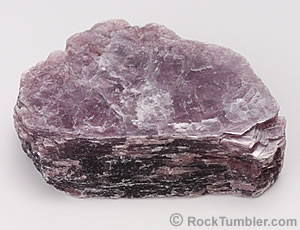
Lepidolite Mica: As a mica mineral, lepidolite occurs in thin flexible sheets that can easily be separated from on another. In this form lepidolite is not suitable for rock tumbling.
What is Lepidolite?
Lepidolite is a lithium-bearing member of the mica mineral group. It is usually grayish-pink, to grayish-red, to grayish-purple in color. Rarely it can be yellow, white, or colorless.
As a mica mineral, lepidolite occurs in thin flexible sheets that separate with little resistance. It is also a very soft mineral with a Mohs hardness of only 2.5 to 3.
Pieces of lepidolite mica are not suitable for rock tumbling. Lepidolite is only suitable for tumbling when it is contained within a rock and is completely cemented into the rock by a more durable mineral such as quartz.
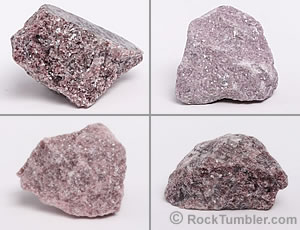
Friable Lepidolite: Rocks that are poorly cemented together will tumble poorly. These rocks crumble easily when they are abraded against one another. These rocks are not good for tumbling but they might be pretty "without being polished". Larger Image
Lepidolite-Bearing Rocks
A few types of rock contain noticeable amounts of lepidolite - enough to give them a pinkish to reddish to purplish color that is characteristic of lepidolite. These rocks are rare.
Most lepidolite-bearing rocks are not suitable for tumbling because they are friable and will break up in a rock tumbler. If these rocks are not heavily impregnated with quartz, they will produce tumbled stones with a surface blemish at every point where a grain of lepidolite intersects the stone's surface.
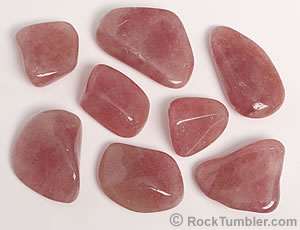
Pink or Red Aventurine: These aventurines often receive their color and sparkle from included flakes of lepidolite. Just a few percent lepidolite by weight can be enough to color these rocks - but too much lepidolite or coarse-grained lepidolite will cause them to produce ugly, pitted tumbled stones.
Identifying "Below Tumbling Grade"
Most lepidolite-bearing rocks are below tumbling grade. "Below tumbling grade" means that the rocks will not produce nice tumbled stones.
You can often identify lepidolite-bearing rocks that are "below tumbling grade" by this test: Pick up two pieces of the rock, one in each hand. Press them firmly together, then rub them aggressively against one another. Do not be wimpy when doing this test. Grind the rocks together with some force! If they shed abundant particles from the friction, or if the surfaces of the rocks are deformed, they are not durable enough to produce nice tumbled stones.
Please Note: The test described above is destructive and should be done only on rocks that you own or have permission to subject to destructive testing.
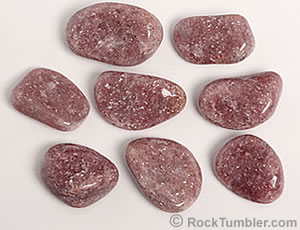
Lepidolite Impregnated by Quartz: This material often performs poorly because the lepidolite is too abundant, too coarse, or not fully impregnated by quartz. The stones above are marginal because the lepidolite is very coarse and not well impregnated.
Buy Lepidolite With Caution
A person buying lepidolite-bearing rocks for tumbling must be very cautious because most of these rocks will not produce nice tumbled stones. These rocks are best purchased at a show or a shop where you can pick them up, examine their surface texture, and decide if the lepidolite is securely enclosed within the rock.
Please Note: A respectful customer will not do the destructive test described above in a shop or at a show. The rocks on display are property of the vendor. However, you can look for debris in the bottom of the bin to determine if the rocks are shedding particles. You can also examine the pieces offered for sale and see if they exhibit abrasion damage. This is often all of the testing that is needed.
If you are interested in using the rocks for tumbling, ask the sellers if they have some tumbled stones that were produced using the rough. Ask if they have instructions for tumbling the material. Keep in mind that many sellers are not rock tumbling hobbyists. They simply buy and sell colored rocks and assume that they can be used to produce tumbled stones. It is up to you to confirm that you are buying quality material.
If you are purchasing rough from an online seller, look for sellers who publish information about the types of rock that they sell and who publish photographs of tumbled stones that they have produced from the same rough that they are selling. These sellers know their merchandise and can advise you on the tumbling process needed to produce nice tumbled stones.
If you purchased a material sold as "lepidolite tumbling rough" and can't get good results when tumbling it, we suggest that you get in touch with the seller. In our opinion, the seller should be able to provide step-by-step rock tumbling instructions for any rock that they offer for sale as a "tumbling rough". We believe that it is their "duty".
Instructions for Tumbling Lepidolite
We do not plan to publish step-by-step instructions for polishing lepidolite-bearing rocks in a rock tumbler or providing advice for the rough sold by other vendors. Why? Because these materials occur in many different forms, most of which cannot be tumbled successfully.
This is when rock tumbling instructions must be developed specifically for the composition of the rock, its texture, its size, and for the type of tumbler. This information can only be determined after careful examination - and sometimes only by testing in a tumbler.
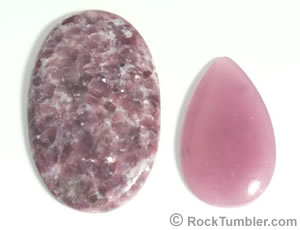
Cabbing Grade Lepidolite: These cabochons were cut from superb material. The one on the left is coarse-flake lepidolite completely impregnated by quartz. The cab on the right is quartz containing a few weight percent of extremely small lepidolite grains - just enough to impart a purplish-pink color to the stone.
Rare, Tumbling-Grade Lepidolite
The lepidolite-bearing rocks that are most likely to be of tumbling grade include:
A) Quartzite with scattered lepidolite flakes: This material is often called "pink aventurine" or "red aventurine" depending upon the intensity of color. If the flakes of lepidolite are few and scattered, it might be worth polishing (it takes only a few percent lepidolite by weight in a translucent to transparent stone to impart a pinkish to reddish to purplish color). If there are a lot of surface-reaching lepidolite flakes or masses of friable lepidolite within the rock, it is likely to fall apart during tumbling, or it may produce tumbled stones with an undesirable appearance.
B) Lepidolite heavily impregnated with quartz: In these rocks, the quartz is so abundant that the lepidolite grains are completely surrounded by quartz. If you closely inspect the surface of these rocks, you might see flakes of lepidolite below the surface, but the surface-reaching flakes of lepidolite will be hard. The flakes will be difficult to dislodge, shred, or deform with abrasion. The lepidolite in these rocks is entirely embedded within the quartz.
These Rocks Can Be Nice Without Tumbling!
Lepidolite-bearing rocks are often very attractive in the rough. Their pinkish to purplish color can be very pleasing, and the sparkle of light reflecting from the mica faces attracts attention. Many people enjoy them as mineral specimens, use them for home decor, or use them in New Age practices. Rocks that are below tumbling grade can still have many potential uses.
Happy Tumbling!
RockTumbler.com Authors
 |
Hobart M. King has decades of rock tumbling experience and writes most of the articles on RockTumbler.com. He has a PhD in geology and is a GIA graduate gemologist. He also writes the articles about rocks, minerals and gems on Geology.com. |

